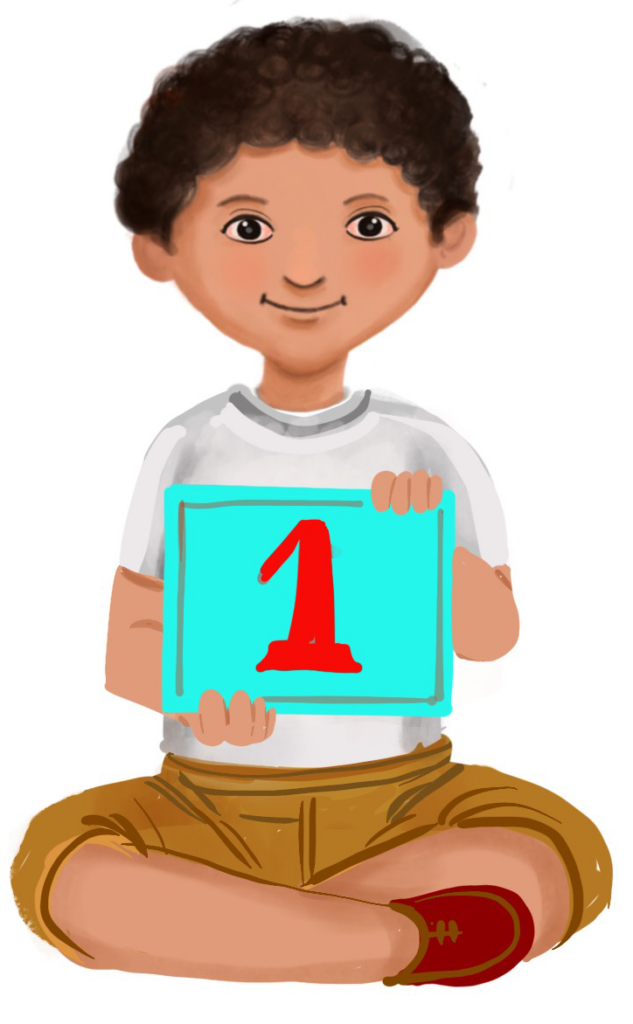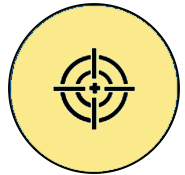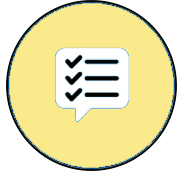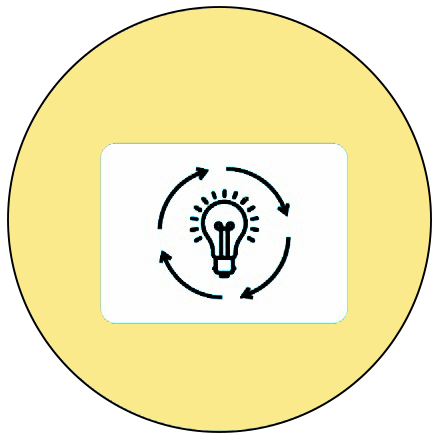
Solid Shapes
Learning Outcome
Identifies 2-D (e.g., square, rectangle, triangle and circle) and 3-D shapes by their names (e.g., cuboid, cylinder, cone and sphere) and describes their observable characteristics (e.g., the pages of a book are rectangular and have 4 sides, 4 corners; a cube has six faces).
 Objective
Objective
Children will be able to name and identify solid shapes around them.
 Prerequisites
Prerequisites
- Children are able to see, recognise and say the 2-D shapes.
- The teacher can have a simple check for understanding at the beginning of the lesson by asking the children to say the shapes through flash cards or real objects available in the classroom.
 Pre-teach Vocabulary
Pre-teach Vocabulary
Square, rectangle, triangle, circle
Material required:
- Flashcards of different shapes
- Objects from the surroundings Example: Pencil box, chalk, duster, ball, dice
LTM: Printable flashcards – Shapes – Coming soon
Introduction: Solid Shapes
The teacher may start with the revision of shapes by showing flashcards.
The teacher could use any available objects and start the class. Since the children already know 2D shapes, the same could be revised along with flashcards to help them remember the shapes.
To compare the 2-D shapes and 3-D shapes, show a piece of paper and a pencil box and say the paper has only length and width, but a pencil box has length, width, and height.
For introducing 3-D shapes or solid shapes, show the children a few examples of everyday objects
(a ball, a pencil, a cube-shaped box, a juice can, a cone, etc.).
These solid shapes have length, width, and height, which we can hold. Hold the object up and let the children observe the length, width and height of the objects.
Showing the cube, the teacher could say, a cube is a box- shaped object with six faces. All the faces are squares and all the sides are equal. For example: a dice, an ice cube, a Rubik’s cube, and a sugar cube.
The teacher could describe the distinguishing features of the cube.
A sphere is a round, ball-like shape with no faces, edges, or corners.
Examples: Muskmelon, watermelon, Earth, and balls of different sizes.
A cylinder looks like a tube or can. It has two circular faces at the top and bottom and one curved surface around the sides.
Examples: Pipes, cans, candles, dustbins, batteries, and water tanks.
A cone has one circular face at the bottom and one curved surface that narrows to a point at the top.
Examples: Christmas tree, party cap, traffic cones, and a carrot.
Show pictures or flashcards of the 3-D shapes or solid shapes: cube, sphere, cylinder, and cone. While showing the shapes, say the name aloud and ask the children to repeat the names.
 Note to the teacher:
Note to the teacher:
The teacher could do more revision by playing a game.
Video: Solid Shapes – Coming soon
ISL Video: Solid Shapes – Coming soon
Activity 1: Sort Me by Shape
Objective: To sort the objects into the appropriate categories.
Importance of the activity for children:
Helps in developing:
- Cognitive Skills (Memory, shape recognition, features identification)
- Fine Motor Skills (Picking the object, holding the object)
- Gross Motor Skills (Walking around, standing, articulating, drawing)
- Language Skills (Vocabulary building, listening, comprehension)
- Social Skills (Playing together in a group)
- Emotional Skills (Sense of achievement on completion builds self-esteem)
Resources required:
- Real- life examples of solid shapes:
- Cube: Rubik’s cube, dice, small cardboard box
- Cylinder: A soda can (Pepsi or Coke), Badminton shuttlecock holder (cylindrical box)
- Drawing sheets and drawing materials (colour pencils, crayons)
Setting for the activity:
The activity can be done indoors or outdoors depending on the availability of space.
Type of activity: Group activity
Preparation of activity:
The teacher should ensure that there is more than one object for each shape.
Role of the teacher:
Demonstrator and facilitator. Observe their sorting activity to check if they are able to sort the real-life examples.
Procedure:
- Divide the class into small groups.
- Keep the objects to be sorted on the ground in two different places.
- Allot one shape to each group to be picked up from the objects.
- Allow two groups at a time and tell them to pick within 5 minutes.
- Give chances to all the groups.
- Let the children check whether they have picked up objects according to the allotted shape. If some more objects of the allotted shape are left behind, give them another chance to pick them up.
- Distribute the drawing papers and pencils or crayons to each group.
- Ask the children to draw at least one example of the solid shape they have collected.
- Encourage them to be creative and motivate them to add more details to their drawings.
- Let one child from each group say the distinguishing features of the solid shape allotted to their group.
Observation:
The teacher can note down his or her observations and guide the children accordingly. For example, if the child is still confused about recognising the shape, he or she can help the child by showing the flashcard.
Suggested variation in the activity:
- The teacher can make this an individual activity.
- The difficulty level can be increased by adding more real-life objects.
Conclusion:
Children would sort the objects according to their shape: cube, cylinder, sphere, and cone.
Children would be able to describe the solid shape verbally.
Video: Sort me by shape – Coming soon
ISL Video: Sort me by shape – Coming soon
Activity 2: Shape Construction Challenge
Objective:
To recognise and create a solid shape in a playful way.
Importance of the activity for children:
Helps in developing:
- Cognitive Skills (Memory, shape recognition, features identification)
- Fine Motor Skills (Picking the object, holding the object)
- Gross Motor Skills (creating shapes from clay, etc.)
- Language Skills (Vocabulary building, listening, comprehension)
- Social Skills (Appreciating others)
- Emotional Skills (Sense of achievement on completion builds self-esteem)
Resources required:
Craft sticks, clay, straws and building blocks
Setting for the activity:
The activity can be done indoors or outdoors depending on the availability of space.
Type of activity: Individual activity
Preparation of activity:
The teacher provides the materials to the children.
Role of the teacher: Demonstrator and Facilitator.
Procedure:
- Provide the children with various materials and challenge them to create different shapes using the materials.
- They can make spheres, cubes, cones, cylinders, and pyramids.
Observation:
The teacher observes the children while they are engaged in the activity and assists them if required.
Suggested Variation in the activity:
- The teacher could provide playdough to create shapes.
- Worksheets with the outlines of solid shapes could be distributed, and the children could be asked to colour the different shapes with different colours. (Cube-Red, Cone-Blue, Sphere-Green, Cylinder-Yellow)
Conclusion:
Children learn to create solid shapes and understand their properties in the process.
Activity 3: Story Time
Objective:
To reinforce the features of 3-D shapes.
Importance of the activity for children:
Helps in developing:
- Vocabulary skills (listening to new words)
- Communication skills (listening to a story)
- Emotional Intelligence skills (relating with characters and content in the story)
- Logical reasoning skill (associate objects with features of the shape)
- Emotional skills (sense of achievement on completion builds self-esteem)
Resources required:
Flashcards showing images of different shapes.
Setting for the activity:
The activity can be done indoors or outdoors depending on the space availability.
Type of activity: Group activity
Preparation of activity:
The teacher can ask the children to gather around and listen to the story.
Role of the teacher: Demonstrator and facilitator.
Procedure: Narrating the story
Guess My Shape
Once upon a time, there were three friends in a village called Shape Village. They are Cubie the Cube, Sphery the Sphere, and Cony the Cone. On a sunny day they went out to have a picnic in a park.
Cubey brought some delicious square sandwiches, Sphery rolled over with apples, and Cony brought some ice-cream cones. As they sat down, Cubey exclaimed, “Have you ever wondered what makes us different from each other?”
Sphery bounced happily and said, “I am all about curves! I am perfectly round.
Cony smiled and said, “I have one curved surface that leads to a point, and I am like an ice-cream cone.”
Cubey laughed and said, “I have six square faces, and I am like a little box.
With tummies full and smiles on their faces, they decided to play a game of “guess the shape.”
One friend would describe a shape, and the others would have to guess.
Cubey went first and said, “I have no corners, and all my sides are the same length. Who am I? Sphere rolled in excitement, “I know. You are a circle.
Cubey laughed and said, “No, I am a sphere.” They all had a good laugh as they realized how tricky shapes could be sometimes. They spent the rest of the day playing games, rolling down, and sharing lots of giggles.
The friends enjoyed their day, celebrating their unique shapes and the wonderful world of solid shapes all around.
 Note to the teacher:
Note to the teacher:
The teacher can show the appropriate flashcard while narrating the story. Once the story is narrated, the teacher can ask the children to compare 2D and 3D shapes.
Observation:
The teacher will observe the children’s comprehension of different shapes.
Suggested variation in the activity:
The teacher can ask the children to enact the story.
Conclusion:
The children will learn the properties of different shapes.
Video: Guess my shape – Coming soon
ISL Video: Guess my shape – Coming soon
Check list for teacher:
| Activity | Yes | No | Sometimes |
| Children can: | |||
| Observe around them | |||
| Creatively use the shapes to create collages | |||
| Identify the shapes of objects around them | |||
| Identify the features of solid shapes | |||
| Make different shapes using clay dough, stick | |||
| Focus on the activity | |||
| Complete the activity in the given time | |||
| Do the activity independently | |||
| Express verbally and through actions, expressions, or gestures |
Cross-Curricular Connection:
- Environment class: Ask the children to observe around them and prepare a list of real-life examples of solid shapes they come across.
- Cube: dice, Rubik’s cube, tissue box. Sphere: basketball, orange, or any fruit with a nearly spherical shape.
- Cone: ice cream cone, traffic cone, party cap, or hat.
- Cylinder: A water bottle, a toilet paper roll, a tin can that can be used for food storage.
- In Physical Education class, make them play hopscotch using the shapes.
Home Activity
Objective:
To reinforce the concept of ‘Solid shapes’ through a fun online activity.
Fun Activity: Word Wall – Match the following
Assessment:
The teacher can give the practice worksheet to children that can be followed by an assessment worksheet.
Assessment: Practice worksheet – Solid Shapes – Coming soon
Worksheet: Practice Worksheet – Solid Shapes (Enlarged) – Coming soon
Worksheet: Assessment Worksheet – Solid Shapes – Coming soon
Worksheet: Assessment Worksheet – Solid Shapes (Enlarged) – Coming soon
Adaptations for addressing learner variability: Adaptations and strategies – Coming soon
Teacher Resource Document – Coming soon
| Source and Attribution of images: All images used in the above Assets and Aids are originally created. |
| This digital material has been developed by the Sri Sathya Sai Vidya Vahini Inclusive Education Project, a unit of Sri Sathya Sai Central Trust, Prasanthi Nilayam, as a collaborative offering in the service of our nation. |